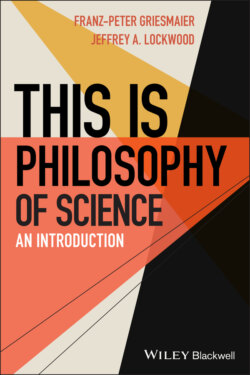Читать книгу This is Philosophy of Science - Franz-Peter Griesmaier - Страница 18
1.4 Facts, Hypotheses, and Theories
ОглавлениеThis may be a good point for some remarks about the relation between facts, hypotheses, and theories. To begin with, facts are actual states of affairs in the world, or how things are. For example, there is the fact that you are reading this sentence right now. This is something that is happening in the world – you reading this sentence is among all the facts that together determine the world. In contrast, hypotheses and theories are (often) linguistic expressions of our beliefs: They consist of sentences purporting to report the facts. For example, the sentence “You are reading this chapter right now” is a hypothesis about you and what you are doing. The hypothesis is right now true (you are still reading, aren’t you?), but once you get bored and look for your friends on social media, it will become false. And this happens because the facts will have changed.
The difference between fact and either theory or hypothesis can be easily overlooked. For example, in discussions about evolutionary biology and creationism, one often hears creationists complain that evolution is just a hypothesis, while the evolutionists call the theory of evolution a proven fact. Both sides here are equally guilty of speaking carelessly. First, evolution is not a hypothesis, because evolution is not a linguistic entity. It is a process that occurs in nature. Evolutionary theory, on the other hand, is a linguistic entity (it’s a bunch of sentences written in books), which can be either true or false. And, of course, evolutionary theory is true if and only if (iff) it corresponds to the facts that comprise the process of evolution, such as the facts concerning natural selection.
Second, there are no such things as “proven facts.” As we have already seen, only mathematical or logical sentences (and the propositions expressed by them) can be genuinely proven. Empirical theories can only be justified by defeasible reasons, which, however, are often strong enough to warrant treating those theories as reporting the facts correctly. Moreover, facts are not the sort of thing that can be proven. You can’t deduce a fact from some premises, because they are not linguistic entities. What you can do is try to bring about some fact, by acting in various ways (e.g., you could apply antibiotics to bacteria to bring about the evolution of resistance). Or you can discover facts. But you can’t prove them – they are the wrong kind of thing for that.
Finally, what’s the relation between hypotheses and theories? It seems that we often try to use the distinction to mark a difference in how well supported an empirical claim is and how comprehensive its content is. We demand better support for a theory than may be required for a (mere) hypothesis, which is often thought of as something like an educated guess, a conjecture, or a sort of hunch.
If we approach the matter a bit more systematically, we can think of hypotheses as relatively isolated or “stand alone” empirical claims. For example, in scientific modelling, we are often only interested in correctly identifying relations between dependent and independent variables (such as period and length in a pendulum). This can be done regardless of how the resulting model fits together with other things we believe.
When we propose a theory, however, we typically try to fit several hypotheses together into a coherent whole. Recall the earlier example involving the ideal pendulum law. During the process of fitting a curve to the data points you collected, you might think of the result as your hypothesis about how period and length are related. You can then go on and embed this hypothesis into a comprehensive theory or encompassing model, such as the theory of simple harmonic oscillators, or even more broadly, into all of classical mechanics.
“Embedding” means that you try to show how your hypothesis can be derived as a special case of a simple harmonic oscillator or as an instance of Newton’s laws of motion (together with some boundary conditions). Such an embedding also means that the evidence for the other parts of the theory becomes indirect evidence for your original model.
Thus, we can draw the distinction between hypothesis and theory in terms of how many different pieces of information have been integrated, although we have to keep in mind that this distinction is vague.
